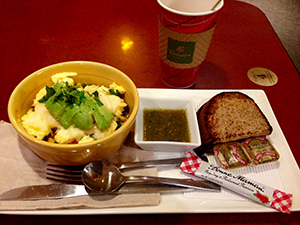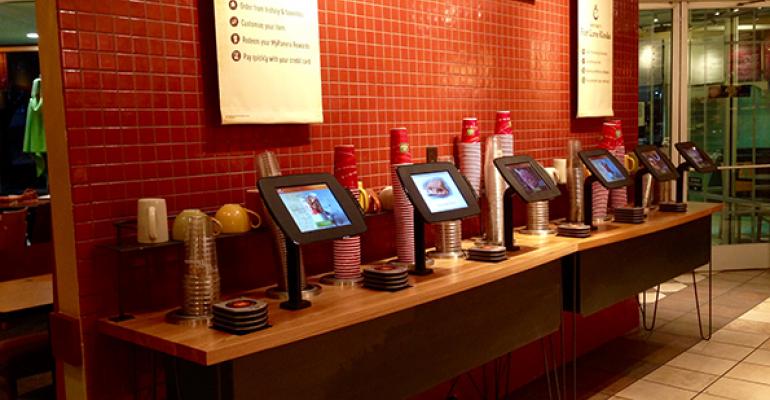
Panera Bread Co. has completed technology and operations upgrades, dubbed “Panera 2.0,” in about 100 of its restaurants since bringing it out of test last March, and the company has said it plans more markets this year.
The St. Louis-based bakery-café chain, which unwrapped Panera 2.0 last March in Boston and Charlotte, N.C., has steadily expanded into five more states.
In the Sept. 30-ended third quarter, the company had completed 43 Panera 2.0 upgrades and targeted as many as 65 more by the end of 2014. The company has about 1,845 restaurants nationwide.

Panera 2.0 offers significant changes in technology and operations, including allowing customers to sit, place online orders via the website or mobile app on their smartphones, and have food delivered to their table. The 2.0 conversions also include kiosks for ordering and dedicated areas for picking up to-go orders.
The order-at-the-table alternative to traditional counter ordering is a major impact on the guest experience, said Ronald M. Shaich, cofounder, executive chairman and chief executive of Panera, during a recent analyst call.
“Customers can just go and sit down after ordering, avoiding the mosh pit all together,” Shaich said. “This higher-quality experience differentiates Panera from fast food, and even much of fast-casual. We think of it as a more polished version of fast-casual.”
Shaich said the Panera 2.0 conversion was completed in the 23-unit Dallas market in the fall, following four test cafés in Boston and 16 cafés in the Charlotte market that were completed in June 2014.
Scheduled fourth-quarter 2014 conversions included locations in parts of California, Florida and Nebraska, as well as units in the Seattle area.
“We continue to learn and iterate with each market we roll into, and we are getting smarter with each café we convert,” Shaich told analysts. “For example, we are hearing feedback from customers, operators and associates, and then incorporating that feedback before moving to the next market.
“In addition,” he said, “we are playing with different levels of investment to support 2.0, and we are moving down the learning curve in terms of the costs, particularly in labor, needed to transition, startup and operate 2.0 cafés.”
The company estimates that each Panera 2.0 conversion has a capital expense of $125,000, he said. “That level of investment could migrate downward as we learn more from the next wave of conversions,” Shaich said. In addition, startup, transition and training costs are estimated to be $20,000 to $30,000 per unit, he said.
After the conversions, Shaich warned that restaurants would also see increased operating expenses, including those for labor, credit card fees, information technology support and depreciation. “This increased cost is obviously mitigated in its impact on margins, as sales increase and as the percentage of orders taken digitally rises,” he added.
Shaich emphasized that one of the most effective parts of Panera 2.0 was the potential increase in throughput, especially with the “Rapid Pick-Up” area, which allows customers to grab their prepaid orders from an area of shelves without standing in line. The success of that element led to its acceleration to the entire system by the start of this year.
“After seeing the power of Rapid Pick-Up in Panera 2.0 units, we decided to roll it out fully to the system in 2014, instead of waiting for full Panera 2.0 conversions,” Shaich said. The company plans to start promoting Rapid Pick-Up, or RPU, “more intensely,” he said.
No longer a small sandwich shop
Shaich added that the company was dealing with “the reality” that it is no longer a small sandwich shop.
“Our bakery-cafés have average unit volume of over $2.5 million,” he said. “During peak hours, our busiest cafés produce an entrée every 5 seconds. To meet existing and new demand, we must have operational integrity.”
Shaich also said the company must be prepared to deal with higher levels of customization on orders. “A statistic that amazes me is that presently, approximately half of our orders are now customized in some way,” he said.
Panera 2.0, which is expected to take three years to substantially convert the entire system, helped the restaurants meet the customization needs of the brand’s “savvy” customers, Shaich said.
Panera Bread Co.’s net income fell 8.3 percent for the Sept. 30-ended third quarter, with higher costs offsetting same-store sales growth, the company reported in late October. Net income slipped to $39.2 million, or $1.46 a share, from $42.8 million, or $1.48 a share, in the prior-year period. Third-quarter revenue increased 8.3 percent, to $619.9 million, from $572.5 million the same period last year.
Same-store sales increased 1.4 percent systemwide, rising 2.1 percent at company-owned units and growing 0.7 percent at franchised locations.
As of Sept. 30, Panera had 1,845 bakery-cafés in 45 states and Ontario, Canada, operating under the Panera Bread, Saint Louis Bread Co. and Paradise Bakery & Café names.
Contact Ron Ruggless at [email protected].
Follow him on Twitter: @RonRuggless





